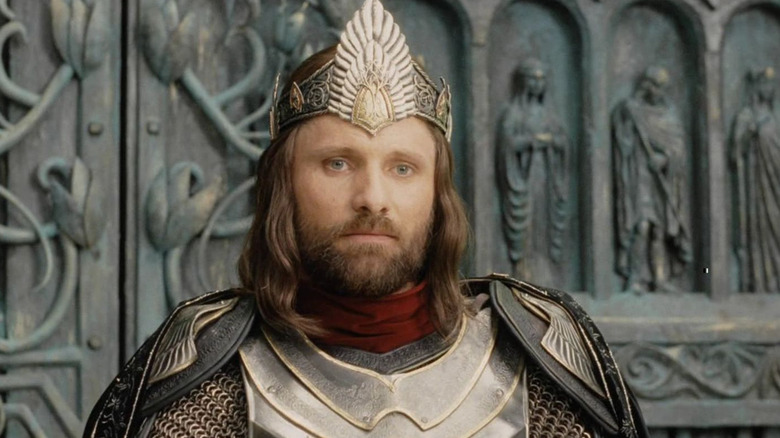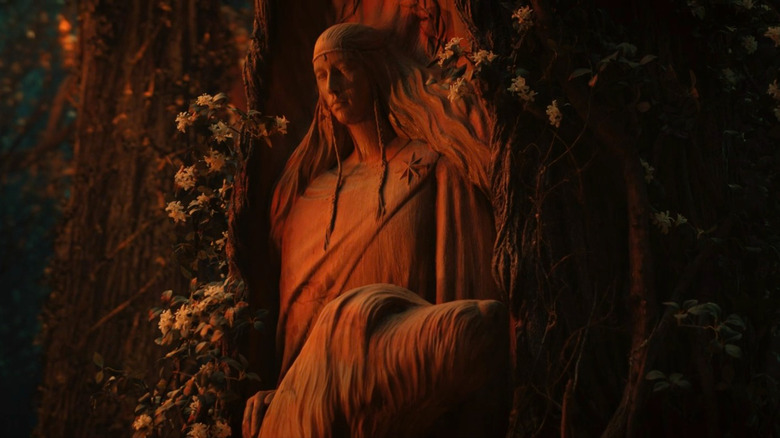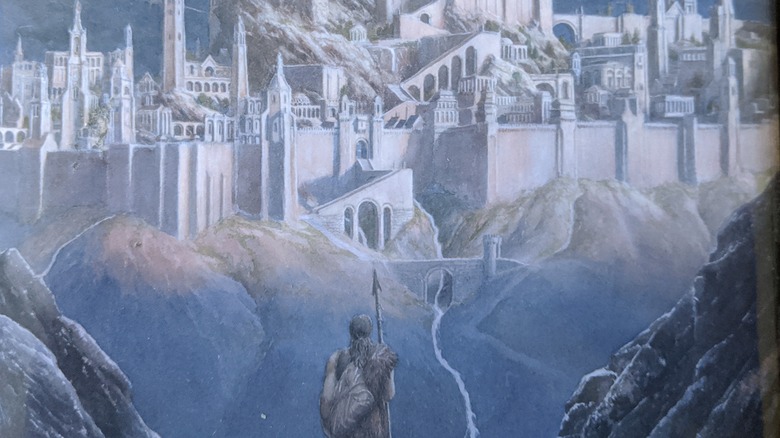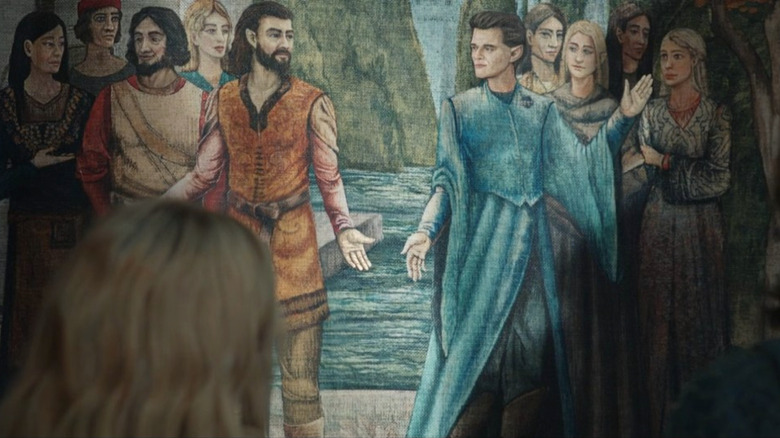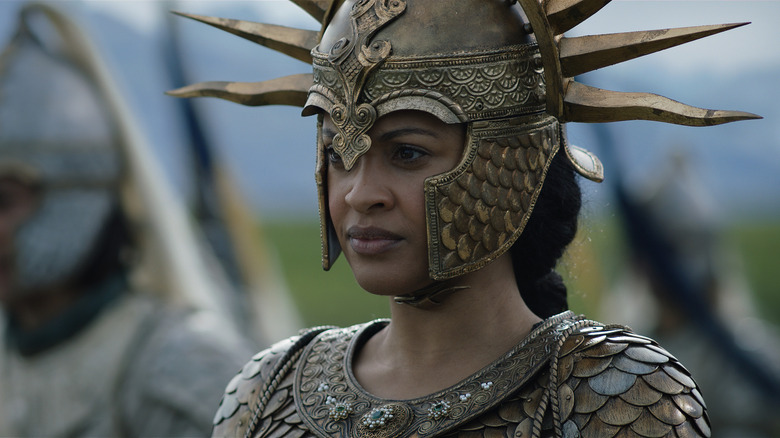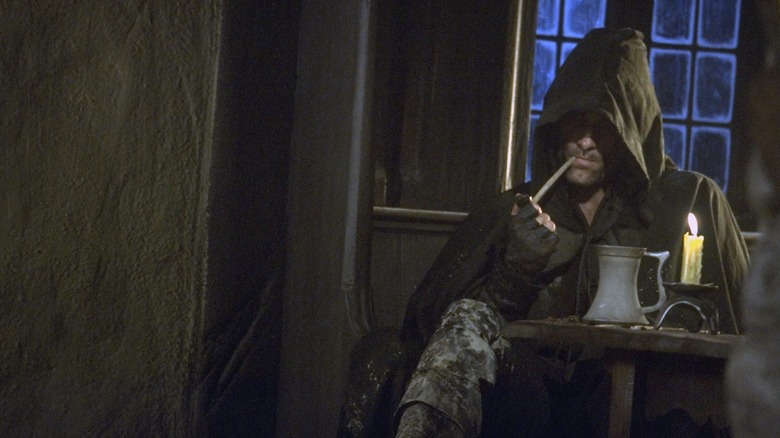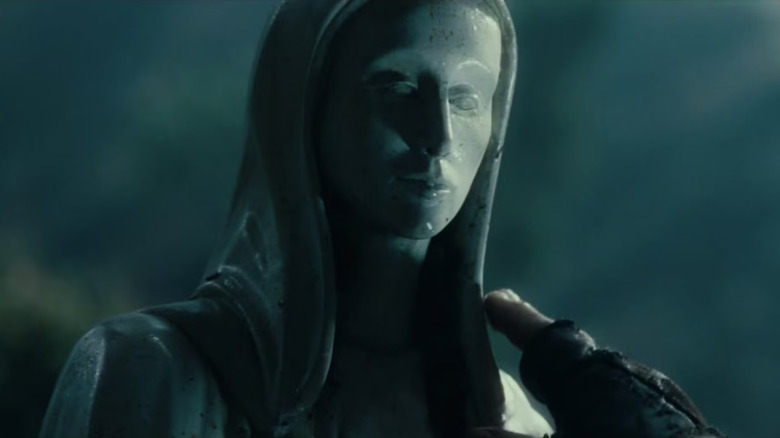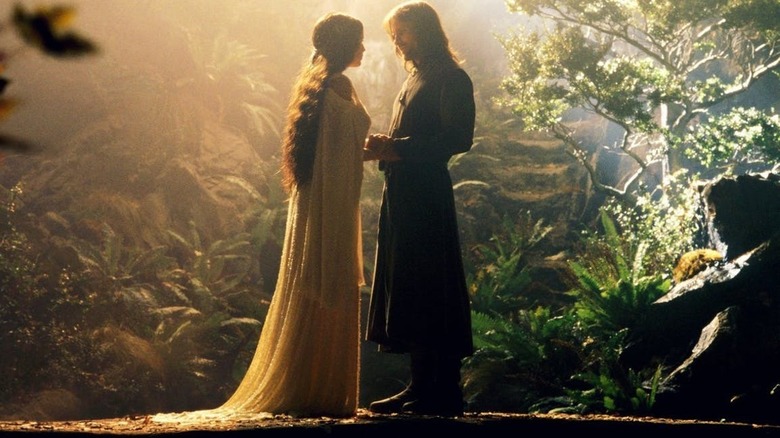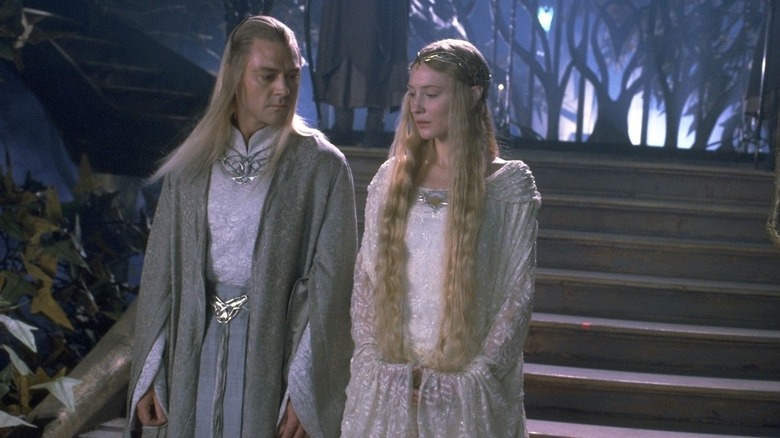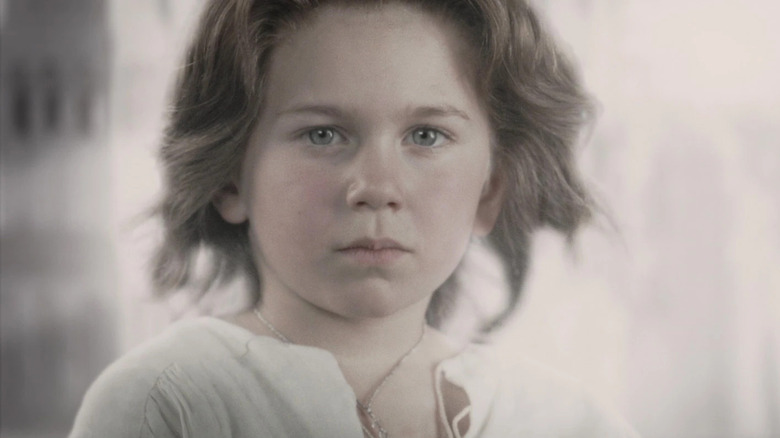Lord Of The Rings: Aragorn's Family Tree Explained
Aragorn is one of the most inspiring people in "The Lord of the Rings" (And hopefully someone we'll see in the upcoming "The Hunt for Gollum" movie.) The exiled king is the perfect servant leader. He puts others first, possesses deep wisdom, and is willing to suffer for the good of others. But what's up with the king moniker? Sure, Aragorn's character and personality are the hero gold standard, but what is it about the man wandering the wilderness around Bree that makes him worthy of a crown, too?
Aragorn's claim to power is actually pretty complex, and it stretches back tens of thousands of years. It includes mortals, immortals, and even a heavenly being tossed into the mix. The man also has connections to some of the most important people in all of Middle-earth history. I've gone through and gathered up the most important of those individuals, and let me tell you, this list is about as good as it gets when it comes to power players in J.R.R. Tolkien's world. From ancient Elvish kings and their angelic brides to Sauron-slaying warriors, wolf-hunting chieftains, immortal in-laws, and much more, here is the complex, convoluted, and overall inspiring family tree of the Man of the West himself: Aragorn II, son of Arathorn, Chieftain of the Dúnedain and High King of Gondor and Arnor.
Aragorn is related to an angel
Let's start with Aragorn's oldest ancestor: Melian. Melian is a member of the group that Tolkien calls the Maiar, an angelic race that chooses to enter into and help create Middle-earth. If you've heard of the Valar before (the spiritual guardians of Middle-earth), the Maia are basically slightly smaller versions of that order. The Wizards are Maia, for instance. Very powerful, but not as powerful as their strongest peers.
The book "The Nature of Middle-earth" explains how early in her story, Melian was the only female spirit in a group called the Five Guardians, a quintet of Maia who were sent to protect the Elves after they awakened in the far east of the continent.
Like the Wizards, later in her story, Melian eventually goes further than her spiritual form. She becomes incarnate and falls in love with an Elvish king named Thingol. This is an utterly unique pairing, as angel and immortal Elf pair up and end up leading one of the most famous kingdoms in "The Silmarillion": Doriath. As far as Aragorn's ancestry is concerned, during their centuries-long rule, Melian and Thingol also have a daughter, Lúthien, who becomes one of the most famous individuals in all of J.R.R. Tolkien's writing.
Aragorn is related to the power couple Beren and Lúthien
Lúthien Tinúviel is the half-Elf, half-Maia daughter of Melian and Thingol. She is a powerful supernatural being, and like her mom, she marries someone technically below her status in the form of the human Beren. Not to knock Beren. He's a human of royal blood. But he's on the run and his kingdom is destroyed when he meets Lúthien. He just doesn't stack up to her royal blood or spiritual power, and her dad knows it and isn't happy.
Like Lúthien's parents, though, it's love at first sight. Dad gives Beren an impossible quest to stop them from getting married, and this leads ot one of J.R.R. Tolkien's greatest tales of the Elder Days (found in "The Silmarillion"). The story traces the lovers' epic quest to recapture one of the hallowed jewels called the Silmarils. They have to infiltrate the stronghold of the Dark Lord Morgoth, and Lúthien repeatedly gets Beren out of some pretty tough scrapes. They shapeshift, there are deadly sing-offs, and people come back from the dead. This is also the story where Galadriel's brother, Finrod, is killed by Sauron — this ended up being a central theme for "The Rings of Power" Season 1.
It's pretty fantastic stuff, but again, for our purposes here, what really matters is that Beren and Lúthien do get hitched and they have a son, Díor. He has Maia, Elvish, and Human blood and becomes the new king of Doriath. Díor also has a daughter called Elwing. Remember that name.
Aragorn is related to Tuor and Idril
J.R.R. Tolkien focused on three epic power couples during the First Age of Middle-earth history, each of which included some combination of mortal and immortal ancestry. Their stories are all found in "The Silmarillion," and their bloodlines all converge to create some critical moments in both Tolkien's world and Aragorn's family tree. Beren and Lúthien are the first of these couples — and the one that was influenced by Tolkien's romance with his wife.
The second of these couples is Tuor and Idril. Idril is an elvish princess of the hidden city of Gondolin. Tuor is a human hero who is sent by the Valar to warn of Gondolin's impending destruction. After delivering his message, Tuor stays in Gondolin, falls in love with Idril, and they have a son named Eärendil. The trio escapes when the city is destroyed and plays a critical role in helping the survivors flee to the western coastline of Middle-earth. Once relocated, Tuor and Idril build a ship and sail across the sea in search of Valinor, the immortal Blessed Realm, where Elvish legend claims Tuor becomes the only man to ever receive immortality. In a letter in 1954, Tolkien specifically said:
Túor weds Idril the daughter of Turgon King of Gondolin; and 'it is supposed' (not stated) that he as an unique exception receives the Elvish limited 'immortality.'
While Tuor and Idril are a big deal, though, their son is even more important.
Aragorn is a direct descendant of Eärendil
Eärendil grows up in the Elvish refugee colony from which his parents sail west. It's there that he meets Elwing, and the two get married. Once again, similar behaviors run in the family, and Eärendil finds himself building a ship and sailing West like his parents. While the story is complicated, the short version is that Eärendil goes to request help from the Valar to stop Morgoth, whose armies are overrunning Middle-earth. Elwing is nearly killed by these armies while her husband is away at sea, but she is transformed into a bird and flies after him. Together, the pair reach the shores of Valinor, successfully ask for help, and then Eärendil and his ship are tasked to sail the skies as a star.
The story is as epic as it is unusual. When it comes to Aragorn's lineage, though, the key factor is that before Eärendil and Elwing head West, they have twin boys. One is named Elros, and the other is Elrond. (Yes, that Elrond.) The twins are captured by other Elves and survive into adulthood. Buckle up. This is where Aragorn's lineage starts to really get wild.
Aragorn is related to Elros
We all know who Elrond Half-elven is (and we'll hear a bit more about him later), but Elrond's brother Elros is also a big deal. Due to their mixed Elvish/Human/Maia heritage, both twin brothers are allowed to choose whether to live a mortal or an immortal life. Elrond famously chooses immortality and becomes incredibly wise and a central resistance point to Sauron in the millennia to come.
But Elros? He chooses mortality and becomes the first king of a blessed nation of men on the island of Númenor. Elros lives to be exactly 500 years old and spends 410 years of that life turning the new nation of Númenor into a powerhouse spot off the coast of Middle-earth. While there are royals and important people in Aragorn's lineage up to this point, Elros is a defining moment in his claim to the thrones of Gondor and Arnor, as those kingdoms connect directly to Númenor and its first king.
Aragorn is related to Tar-Palantir and Tar-Míriel
Númenor has a lot of kings. In fact, the island nation thrived for nearly 3,300 years during the Second Age. This means, despite their long-lived nature, the list of kings and queens of Númenor is a long one, and Aragorn is related to all of them. But don't worry, we won't go through a mind-numbing string of confusing Tolkienian names here. Instead, we'll highlight two royal individuals of note: Tar-Palantir and Tar-Míriel.
As the centuries pass, the leaders of Númenor rule an island that thrives and has a positive influence on Middle-earth ... at first. Eventually, though, the peace is tarnished by corrupt and ambitious kings who turn away from the blessings and friendship of the Valar and the Elves and seek after their own unrestricted power. Tar-Palantir is the 24th king and one of the last ones who makes a serious effort to return to the good old days. His daughter, Tar-Míriel, is in line to become the fourth ruling queen in the island's history, but her throne is forcibly usurped by her cousin, Ar-Pharazôn, leading to the downfall of the entire kingdom.
I mention these three here not just because they represent a dramatic part of Aragorn's family history, but because all of them are central figures in Prime Video's "The Rings of Power" series. (I even interviewed Cynthia Addai-Robinson, who plays Míriel on the show, in 2024 about her Season 2 storyline.) It's fun stuff and peak drama for the Númenórean branch of Aragorn's ancestry.
Aragorn is related to Elendil and Isildur
The other two characters from "The Rings of Power" that we'll mention here are Elendil and Isildur. This father/son duo starts as distant relatives to the throne of Númenor. When the island nation is destroyed in an Atlantis-like catastrophe, though, they are the survivors of the royal house who reach the mainland. There, they set up two kingdoms: Arnor in the north and Gondor in the south. Elendil technically rules both as the High King, but he focuses on the north. Isildur co-rules the south with his brother Anarion.
Elendil becomes a standard for ideal kingship, and Aragorn is still echoing his name thousands of years after his death. He's the one who is killed by Sauron in the fight on Mount Doom (as seen at the beginning of "The Fellowship of the Ring"). Isildur is also an important king, and he's the guy whose fate includes both cutting the One Ring from Sauron's hand and then keeping it for himself.
Aragorn is related to countless Chieftains in exile
At this point in the timeline, Aragorn's Elvish relatives are mostly alive and kicking, and the Númenórean line of kings has ended. Gondor continues to have kings related to Aragorn for a while, but eventually these peter out and are replaced by stewards who hold the throne waiting for the king to return (and thus, setting the stage for the "Return of the King" story). In the north, the kingdom of Arnor breaks apart and then collapses, leaving a collection of wandering Númenórean descendants called the Dúnedain. There aren't a lot of them, but they still have their people's blessed physique and long life, and they stand out amongst the Humans on the continent.
The exiled Dúnedain are ruled by chieftains, the same way Númenor had kings, and in the same vein, we aren't going to list all of them. However, one Chieftain of the Dúnedain that we will bring up is Aragorn. No, not that one. We're talking about Aragorn I. We know almost nothing about the first Aragorn, but he lived to be 100 years old, and "The Return of the King" tells us:
Aragorn I, it is said, was slain by wolves, which ever after remained a peril in Eriador, and are not yet ended.
Aragorn I is the fifth Chieftain of the Dúnedain, and he rules during a quiet yet critical time called the Watchful Peace, roughly 600 years before Aragorn II (our Aragorn) is born.
Aragorn's father and mother are Arathorn II and Gilraen
Aragorn's dad, Arathorn II, is the fifteenth Chieftain of the Dúnedain. He marries a young lass named Gilraen, whose mother encourages the nuptials, prophesying (in "The Return of the King" appendices):
The days are darkening before the storm, and great things are to come. If these two wed now, hope may be born for our people; but if they delay, it will not come while this age lasts.
Arathorn II and Gilraen hook up, and our boy Aragorn pops out two years later. Two years after that, his dad is killed when he's shot in the eye by an orc-arrow, making it a narrow shave as far as preserving the line of kings is concerned.
Gilraen lives longer, and she and Aragorn move to Rivendell after Arathorn II's death to raise the young heir of Isildur in better safety. The appendices add:
Elrond took the place of [Aragorn's] father and came to love him as a son of his own. But he was called Estel, that is "Hope", and his true name and lineage were kept secret..."
Gilraen continues to have an important influence on her son as he grows, and, to be honest, she's a bit of downer. She even warns him that he doesn't really have a shot with Arwen. Eventually, Aragorn grows up and goes out adventuring. Gilraen moves back in with her own people and dies at the ripe age of 100 years old.
Aragorn is Arwen's husband (and distant cousin)
Everyone and their mother knows about Aragorn and Arwen. They're one of the few times in Middle-earth history that mortal and immortal folk get hitched. Although I like to point out that even that isn't as cut and dry as it looks. It's easy to write off Arwen as an Elf and Aragorn as a Man. Arwen gives up her immortality and, hey presto! They're a mortal couple. In reality, though, both of them are part Human and part Elf, even if Arwen is much more the latter and Aragorn is more of the former.
If you trace their lineage back far enough, both have a tiny dash of angel in the mix, too — and yes, that does mean they're also related. If you go back dozens of steps through Aragorn's family tree, eventually you get to Elrond, and Arwen is, of course, his daughter. So the two are technically cousins, but it is so many degrees removed that it's hard to even figure out. Suffice it to say, the distance is so great that it doesn't matter much — especially to an author who lived in a country (Great Britain) where royal cousins of much closer degrees got married all the time.
Aragorn's in-laws: Galadriel, Elrond, and others
Weird connections aside, Aragorn and Arwen get married, which makes this a great point to explore the in-law side of this wacky, overpowered family tree. First, there are Arwen's twin brothers, Elladan and Elrohir. Aragorn is related to them both through marriage and very distant cousin connections. His mother-in-law is Celebrían, the daughter of Galadriel and Celeborn, which means Aragorn manages to add that famous Lóthlórien power couple to his family tree as well.
That opens up another menagerie of immortal connections, but since we're just talking about in-laws here, the only other individual I'll bring up right now is the Elvish high-lord Finarfin. He is one of the oldest Elvish kings in all of Arda (the Earth), and he remains behind in Valinor when Galadriel and others leave its blessed shores to go to Middle-earth. That means Aragorn even ends up directly related to an ancient Elven lord who is still actively ruling his people in the heavenly, hallowed halls and lands of the Valar half a world away.
Aragorn's children
Finally, we have the other side of Aragorn's family tree: his children. Once Aragorn and Arwen get married, they have several kiddos. One of these is a boy named Eldarion, who becomes king when his father dies at the ripe old age of 210 years. (Remember, he has that Númenórean blood that allows him to live longer and stronger.)
There are other kids in the mix, but they are not named or even numbered. Instead, we get a single line that mentions them. When Arwen is about to die in "The Return of the King" appendices, it says:
Then she said farewell to Eldarion, and to her daughters, and to all whom she had loved..."
That's it. A single mention of "her daughters," indicating that there are at least two more girls, along with Eldarion, and possibly more. Well, folks, there you have it. That's all we get of Aragorn's official, named family tree. Though presumably, we would have learned a little more if J.R.R. Tolkien had ever gotten around to finishing "The New Shadow," the unwritten sequel to "The Lord of the Rings," which takes place later in Eldarion's reign. Ah, what could have been...
